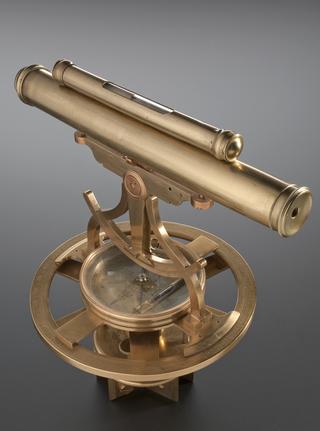
Gunter type measuring chain
- Made:
- 1857-1865
- maker:
- Baker, Charles

Gunter type surveying chain, 100 links (66 feet), by Charles Baker, 244 High Holborn, London, England, 1857-1865
Ropes, chains, tapes and rods have all been used for measuring distances. In about 1620, English mathematician and astronomer Edmund Gunter (1581-1626) developed this type of metal chain for determining the area of plots of land. The chain is 20 metres (66 feet) long, and is made of 100 links. Markers are placed at regular intervals.
The Gunter's chain was most generally employed in England. In the measurement of considerable distances it slowly replaced the cord, which was more liable to stretch, and the surveyors rod or pole, the use of which was a laborious operation where accuracy was required. It consists of 100 links and has a total length of 66 ft, which length has since been known as a Chain. All Gunter's chains are provided with brass tellers, inserted at every 10 links, for convenience in counting fractions. One advantage of Gunter's Chains over others is that it gives areas directly in decimal fractions of 1 acre, for 1 acre = 100,000 square links.
Chains had to be compared with a standard length, and the links hammered into the correct shape if they deformed during use. Invar, a nickel-steel alloy, was very useful for making tapes as it does not expand or contract much when the temperature changes.
The example shown is made of iron, with brass handles, as was formerly the custom.
Details
- Category:
- Surveying
- Object Number:
- 1872-78
- Materials:
- brass (copper, zinc alloy) and iron
- Measurements:
-
overall: 80 mm x 470 mm x 300 mm, 3.885kg
- type:
- surveying chain
- credit:
- South Kensington Museum (Circulation Department)




